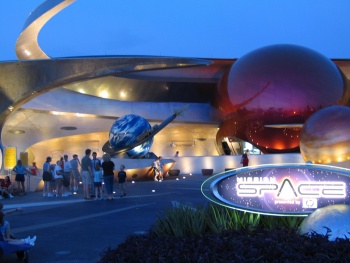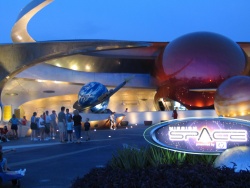Difference between revisions of "Mission: Space"
| Line 43: | Line 43: | ||
Mission: Space begins with a launch countdown, which includes various tension building special effects. Just before the countdown ends, the seats tilt back into launch position. As the space shuttle takes off, guests will feel like they are quickly picking up speed. The the attraction gives off G force of 2.5g, making guests feel 2.5 times heavier then they actually are. After escaping the Earth's gravitational pull, and making their way through space, guests will feel weightless. As the space ship travels toward Mars, each guest must execute their duty. To do this each crew member must press the button in front of them when Mission Control tells them to do so. If a guest fails to accomplish their task, the auto-pilot will take over and do it. Although their are many buttons and switches in front of each guests, they are their only to add realism and do not do anything. | Mission: Space begins with a launch countdown, which includes various tension building special effects. Just before the countdown ends, the seats tilt back into launch position. As the space shuttle takes off, guests will feel like they are quickly picking up speed. The the attraction gives off G force of 2.5g, making guests feel 2.5 times heavier then they actually are. After escaping the Earth's gravitational pull, and making their way through space, guests will feel weightless. As the space ship travels toward Mars, each guest must execute their duty. To do this each crew member must press the button in front of them when Mission Control tells them to do so. If a guest fails to accomplish their task, the auto-pilot will take over and do it. Although their are many buttons and switches in front of each guests, they are their only to add realism and do not do anything. | ||
| + | |||
| + | [[Image:Missionspace.jpg|thumb|The ride controls that guests can use inside Mission: Space.]] | ||
The trip to Mars includes a slingshot around the moon, a simulated hypersleep (to make the time it takes to get to Mars seem more realistic) and a landing on Mars itself. Along the way, the ship may experience various difficulties, depending on how well guests execute their responsibilities. After landing on Mars guests disembark. After exiting the attraction, guests are invited to explore the Advanced Training Lab postshow. | The trip to Mars includes a slingshot around the moon, a simulated hypersleep (to make the time it takes to get to Mars seem more realistic) and a landing on Mars itself. Along the way, the ship may experience various difficulties, depending on how well guests execute their responsibilities. After landing on Mars guests disembark. After exiting the attraction, guests are invited to explore the Advanced Training Lab postshow. | ||
Revision as of 00:49, 7 March 2012
Mission Space is a pavilion and an attraction located in Epcot
| Mission: Space | |

| |
| The exterior of Mission: Space. | |
| Epcot | |
| Land | Future World |
|---|---|
| Theme | Space travel |
| Opening date | October 9, 2003 |
| Type | Motion simulator |
| Sponsored by | Hewlett-Packard |
|
| |
Contents
Pavilion History
It took Imagineers almost five years to complete their concept for Mission: Space. Designs for the attraction began in 1995, and in total over 650 Imagineers worked on the attraction. The original plans for Mission: Space would have featured a motion simulator themed to look like a futuristic space shuttle (similar to Star Tours). The space shuttle would "fly" guests to a space station located on an asteroid. As opposed to the classic motion simulator technology, this version of Mission: Space would have utilized the new technology created for the attraction. The asteroid where the space station was located, would actually be the rest of the pavilion, which guests could walk around and explore.
Originally Imagineers wanted to reuse the building that housed Horizons. Due to the extensive costs of restructuring the building, to suit Mission Space, this idea was eventually scrapped. Instead a new pavilion was constructed on the former site of Horizons which was closed and demolished in 1999. Construction began on Mission Space in September of 2000. Initially the attraction was sponsored by Compaq, who helped design and develop the attraction in May 2000. When Compaq merged with Hewitt-Packard in 2002, HP assumed sponsorship of the pavilion. The simulator hardware used in the attraction was designed and built by Environmental Tectonics Corporation of Pennsylvania. Environmental Tectonics won the contract with a 30 million dollar contract in February of 2002.
Mission: Space celebrated it's grand opening on October 9, 2003 (the ride had been open for "soft openings" since June of that year). On hand for the celebration was Michael Eisner, HP CEO Carly Fiorina and NASA Administrator Sean O'Keefe. Various astronauts also attended the event including: astronauts from the Mercury, Gemini, Apollo, the space shuttle program, and international space station crew members. Also in 2003, the Environmental Tectonic Company sued Disney for 15 million dollars, alleging that Disney had failed to pay the full amount of the contract and that they shared proprietary design details with competitors. Disney counter-sued, alleging that the company had company failed to deliver according to the contract, and that this failure had cost Disney an extra 20 million dollars. The companies settled out of court in January of 2009.
Due to guests complaints of dizziness or headache after riding Mission: Space, On May 19, 2006, Disney began offering a less intense version of the ride called, the Green Team. Guests now have the option of riding the original ride (now known as the Orange Team) or riding the Green Team, during which centrifuge does not spin (creating a tamer ride).
Attraction Plot
Although Mission: Space is considered a pavilion, it really only includes one attraction (titled Mission: Space). The attraction is set in the year 2036, the 75th anniversary of man arriving on the moon.
Queue
In the future, any person with the proper training can travel to space. To get this training, guests are entering the International Space Training Center. As they wait in the queue, they can see various artificial from the history of space travel. A large gravity wheel, and props from the 2000 movie, as well as a replica NASA moon rover can all be seen here.and flags flying overhead give the Training Center an international feel As guests enter the Command Room they will see that plaques commorating the past, present and even future of space travel line the walls. A picture of the first family in space and the "First Deep Space Mission" can be found, reinforcing the idea that space travel has advanced a lot by the year 2036. . As guests continue to make their way through the queue, they can read and hear inspirational quotes from famous astronauts and astronomers including Neil Armstrong, Galileo, President John F. Kennedy, Plato, Kalpana Chawla, Carl Sagen, and even NASA Administrator Sean O'Keefe.
While in the queue guests have the ability to split into two lines. A cast member asks them if they would like to be on the Green Team (the milder version) or the Orange Team (the normal version). After choosing their version of the ride, guests get a colored card and enter the color coded "Ready Rooms". Here, guests watch a short instructional video from CapCom, and they are given their role for the mission. In total their are four assignments that guests can get:
- The Commander
- The Pilot
- The Navigator
- The Engineer
After getting their roles, guests are buckled into their seats aboard the X-2 Rocket, which is almost ready for lift-off.
The Flight to Mars
Mission: Space begins with a launch countdown, which includes various tension building special effects. Just before the countdown ends, the seats tilt back into launch position. As the space shuttle takes off, guests will feel like they are quickly picking up speed. The the attraction gives off G force of 2.5g, making guests feel 2.5 times heavier then they actually are. After escaping the Earth's gravitational pull, and making their way through space, guests will feel weightless. As the space ship travels toward Mars, each guest must execute their duty. To do this each crew member must press the button in front of them when Mission Control tells them to do so. If a guest fails to accomplish their task, the auto-pilot will take over and do it. Although their are many buttons and switches in front of each guests, they are their only to add realism and do not do anything.
The trip to Mars includes a slingshot around the moon, a simulated hypersleep (to make the time it takes to get to Mars seem more realistic) and a landing on Mars itself. Along the way, the ship may experience various difficulties, depending on how well guests execute their responsibilities. After landing on Mars guests disembark. After exiting the attraction, guests are invited to explore the Advanced Training Lab postshow.
The Green Team version of the attraction is essentially the same, however the gravity effects are not used.
Advanced Training Lab
In the Advanced Training Lab their are four different exhibits that guests can visit. They include:
- The Space Base- A playground for young guests with a space theme.
- Expedition: Mars- A video game, in which guests take control of an asturnaut who has four minutes to find four other astronauts on Mars.
- Postcards from Space- In this exhibit, guests can send a short video of themselves with various space themed backgrounds.
- Space Race- A game in which two teams compete against each other to see who can get their rocket from Mars back to Earth the fastest. Up to 60 guests can play Space Race at one time.
Shopping
Mission: Space Giftshop- Located outside of the main attraction, the shop sells Mission: Space and other Epcot merchandise.
Trivia
- There are three references to Horizons in the Mission: Space pavilion. Outside of the pavilion, a planter is shaped like the demolished attraction.
- The Horizons logo can also be seen in the center of the Gravity Wheel located in the queue, and on the check out desk in the pavilions gift shop.
- The Lunar Rover suspended from the ceiling in the queue is on loan from the Smithsonian.
- Trevor Rabin (formally of Yes) composed a new musical score for Mission: Space.
- Imagineers went through nearly 100 different shades of red before settling the color that is used in the pavilions facade.
References
http://www.wdwinfo.com/wdwinfo/guides/epcot/epfw-mission.htm
http://allears.net/tp/ep/e_ms.htm
http://disneyworld.disney.go.com/parks/epcot/attractions/mission-space/
